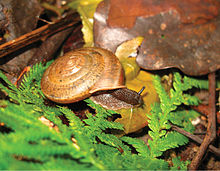| Revision as of 01:17, 15 October 2014 editG S Palmer (talk | contribs)Autopatrolled, Extended confirmed users, Rollbackers27,891 edits Reverted good faith edits by 123.243.147.193 (talk): Unlikely. (TW)← Previous edit | Revision as of 12:24, 17 October 2014 edit undoG S Palmer (talk | contribs)Autopatrolled, Extended confirmed users, Rollbackers27,891 edits ±Category:Molluscs of Japan→Category:Molluscs of Asia; ±Category:Endemic fauna of Japan→Category:Fauna of Taiwan using HotCat. Must have been thinking about something else to write Japan instead of Taiwan.Next edit → | ||
| Line 45: | Line 45: | ||
| ] | ] | ||
| ] | ] | ||
| ] | ] | ||
| ] | ] | ||
| ] | ] | ||
Revision as of 12:24, 17 October 2014
| Aegista diversifamilia | |
|---|---|

| |
| Live individual from Xiulin, Hualien | |
| Scientific classification | |
| Kingdom: | Animalia |
| Phylum: | Mollusca |
| Class: | Gastropoda |
| (unranked): | clade Heterobranchia clade Euthyneura |
| Superfamily: | Helicoidea |
| Family: | Bradybaenidae |
| Genus: | Aegista |
| Species: | A. diversifamilia |
| Binomial name | |
| Aegista diversifamilia Huang et al., 2014 | |
Aegista diversifamilia is a species of air-breathing land snail, a terrestrial pulmonate gastropod mollusk from Taiwan.
Discovery and naming
A. diversifamilia was previously identified as being part of the species A. subchinensis, which was known to occur throughout most of Taiwan. In 2003, a paper was published remarking on the difference between the eastern and western populations of the species. Eventually it was established that the eastern population was a separate species, divided from A. subchinensis by the Lanyang River.
The new species' name is derived from Latin diversus and familia. The name was chosen in recognition of the same-sex marriage movement in Taiwan and worldwide. Dr. Yen-Chang Lee, co-author of the ZooKeys paper describing the species, said: "When we were preparing the manuscript, it was a period when Taiwan and many other countries and states were struggling for the recognition of same-sex marriage rights. It reminded us that Pulmonata land snails are hermaphrodite animals, which means they have both male and female reproductive organs in single individual. They represent the diversity of sex orientation in the animal kingdom. We decided that maybe this is a good occasion to name the snail to remember the struggle for the recognition of same-sex marriage rights."
Description
The shell is depressed and spherical, between 1.98 centimetres (0.78 in) and 3.24 centimetres (1.28 in) wide and 0.97 centimetres (0.38 in) to 1.68 centimetres (0.66 in) high. The shell is thin but strong, with a depressed conic spire. The aperture is ovate, 0.78 centimetres (0.31 in) to 1.32 centimetres (0.52 in) wide by 0.48 centimetres (0.19 in) to 1.05 centimetres (0.41 in) tall.
The shell is a glossy chestnut- or yellow-brown, with a thin light brown stripe running along the periphery. The peristome is white.
Reproductive system
A. diversifamilia is hermaphroditic. The penis is long and thin, but shorter than the epiphallus. The dart sac is positioned in the vagina, which is equal in length to the penis. The spermoviduct is approximately four times as long as the penis and oviduct, and two times as long as the hermaphroditic duct. Individuals lay 20-30 white, 3mm diameter round eggs per spawing.
Range and habitat
A. diversifamilia is endemic to eastern Taiwan, bounded on the north by the Lanyang River. It is found in the Yilan and Hualien Counties, but not on Guishan Island.
The species is usually found in lowland hardwood forests, living in or under moist leaf litter.
References
- ^ Huang, Chih-Wei; Lee, Yen-Chen; Lin, Si-Min; Wu, Wen-Lung (13 October 2014). "Taxonomic revision of Aegista subchinensis (Möllendorff, 1884) (Stylommatophora, Bradybaenidae) and a description of a new species of Aegista from eastern Taiwan based on multilocus phylogeny and comparative morphology". ZooKeys (445). Pensoft: 31–55. doi:10.3897/zookeys.445.7778. Retrieved 13 October 2014.
{{cite journal}}: CS1 maint: unflagged free DOI (link) - ^ Ghorayshi, Azeen (13 October 2014). "New species of snail named in celebration of same-sex marriage". The Guardian. Retrieved 14 October 2014.
- Feltman, Rachel (13 October 2014). "New species of hermaphrodite snail named in support of same-sex marriage". The Washington Post. Retrieved 14 October 2014.
- "Hermaphrodite snail named after marriage equality". BBC News. BBC. 13 October 2014. Retrieved 14 October 2014.
- Huang, Chih-Wei (13 October 2014). "A new land snail species named for equal marriage rights". EurekAlert!. Retrieved 14 October 2014.